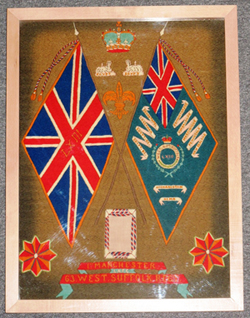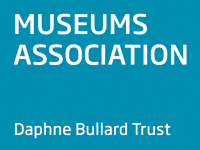Regimental Embroidery
 Although we don’t know anything about the man or woman that made this embroidery we can learn a lot about the history of our Regiment by looking at the many symbols and words that are depicted on the embroidery.
Although we don’t know anything about the man or woman that made this embroidery we can learn a lot about the history of our Regiment by looking at the many symbols and words that are depicted on the embroidery.
Because of these symbols and words we know this embroidery was probably made some time between 1883 (the date of the last battle honour depicted was awarded) and 1901 (the date Queen Victoria died).
What do all he symbols and words on the embroidery mean?
The fleur-de-lys (top centre)
It is believed that the fleur-de-lys (meaning flower of the Lily) was first taken into use by the 63rd Regiment of Foot, later 1st Battalion Manchester Regiment, to mark their part in helping to capture the French owned West-Indies Islands of Guadaloupe (1759, 1810 and 1815) and Martinique in 1809. For a long time after this the Regiment used the symbol on all types of Regimental property such as uniform, crockery and silverware.
During the American War of Independence the Regiment lost all it’s documentation including that believed to grant it title to use this symbol (1795). Despite repeated attempts to regain official permission to use the fleur de lys it wasn’t until 1923 that such permission was granted and the fleur de lys became an official badge of the Manchester Regiment.
When the Manchester Regiment joined with the King’s Liverpool Regiment in 1958, the fleur-de-lys became part of their tradition too. Today soldiers of the Duke of Lancaster’s Regiment continue many of the Manchester Regiment traditions this includes wearing the fleur-de-lys on their uniform buttons.
Do you want to learn more about the history of the fleur-de-lys and its use in the Regiment’s history?
The Brunswick Star (bottom left and right)
This eight-pointed Star (the crown replacing the top point of the Star) is called The ‘Brunswick Star’ and was a symbol used by the Manchester Regiment (and before it the 63rd and 96th Regiment’s of Foot). Regimental tradition states the 63rd Regiment of Foot adopted it originally between 1775 and 1782, when they often rode as mounted infantry under the celebrated cavalry leader Colonel Tarleton, during the American War of Independence.
Separately, it is believed that in 1824 Colonel J. Fuller adopted the Star for the Regiment that he was ordered to raise, in Manchester, and numbered “96”, which later became the 2nd Battalion Manchester Regiment.
Do you want to learn more about the history of the Brunswick Star and its use in the Regiment’s history?
The Colours
The main feature of the embroidery are 2 flags or ‘Colours’.
What is a ‘Colour’?
The Colours have become the symbol of the spirit of the Regiment, for they bear the battle honours and badges granted to the Regiment on commemoration of the gallant deeds performed by its members from the time it was raised.
The association of colours with heroic deeds has caused them to be regarded with veneration. The fact that colours are consecrated before being taken into use, and are laid up in sacred or public buildings after service serves to maintain the atmosphere of veneration with which they are surrounded
Each infantry battalion had 2 colours, collectively called ‘a stand’; the King’s (or Queen’s) colour (on the left in the embroidery) and a ‘regimental colour’ (on the right in the embroidery).
What do the places mentioned on the colours mean?
These are some of the Regiment’s ‘Battle Honours’. These are key campaigns that the Regiment fought in, since the time is was raised, that are remembered, by the Regiment, through the ages.
The Battle Honours mentioned here are:
- Guadaloupe
- Egmont-op-Zee
- New Zealand
- Inkerman
- Sevastopol
- Martinique
- Peninsula
- Alma
- Afghanistan
- Egypt 1801
- Egypt 1882
The Sphinx (Egypt) (centre top)
This is a symbol used by the Regiment to remember its fighting during the Egyptian campaign, fought between 8th March and 26th August 1801 with the aim of expelling Napoleon Bonaparte from Egypt.
On 16 July 1802, Egypt, with the badge of The Sphinx was awarded to all units which had taken part in the 1801 campaign. This distinction is interesting for several reasons: it was the first to be awarded for a campaign and the first to use a badge to commemorate the award. Also, unlike previous awards, it was not considered necessary for the complete unit to have been present to qualify for the honour.
The Regiment was once again in Egypt in 1882 (11 July to 23rd September 1882) – when it earned the battle honour Egypt 1882, awarded in 1883.
The other symbols on the embroidery
- The Crowns reflect the service of the regiment and soldier to the monarch of the day, in this case Queen Victoria.
- ‘LXIII’ are the Roman Numerals for ‘63’ representing the history of the 63rd Regiment of Foot (1758-1881).
- ’63 West Suffolk Regt’. In 1783 Regiments were given territorial titles. The 63rd Regiment of Foot (later 1st Battalion Manchester Regiment) was given this title as an aid to recruiting. These early territorial titles often bear little relation to the units later geographical ties, many of which continue to this day.
‘Stitch in time’ (Sewing Circle)
It was this embroidery that was the catalyst for the Museum establishing its very own sewing circle which is called Stitch in Time (SIT). The group of women and men, was established in April 2010 and they meet twice per month in the Museum of the Manchester Regiment.
This embroidery was conserved by Mrs Jacqueline Hyman and framed by Lancashire County Museum Service with financial assistance from both the Daphne Bullard Trust




